Glycolic Acid
Glycolic Acid’s Surprising Benefits for Hair Revealed
Learn how glycolic acid can transform your hair care routine, unlocking secrets to hydration, shine, and growth that you won’t want to miss.

Glycolic acid's surprising benefits for your hair are worth exploring. It promotes scalp health by unclogging hair follicles and reducing dandruff, leading to a healthier environment for growth. With its moisturizing properties, it helps keep your hair hydrated and enhances softness, making it more manageable. Regular use improves texture and reduces frizz, contributing to a shinier appearance. Plus, its exfoliating action helps remove dead skin cells, fostering better absorption of nutrients. So, if you're curious about how to incorporate glycolic acid into your hair care routine for maximum benefits, there's much more to uncover.
Key Takeaways
- Glycolic acid promotes scalp health by exfoliating dead skin cells and unclogging hair follicles, reducing dandruff and irritation.
- It enhances moisture retention, improves hydration levels, and softens hair texture, making hair more manageable.
- The acid's small molecular size allows deep penetration into the hair shaft, maximizing the benefits of hair care products.
- Regular use of glycolic acid can improve hair texture and shine while reducing frizz for a smoother appearance.
Understanding Glycolic Acid

Glycolic acid, a powerful alpha-hydroxy acid derived from sugarcane, penetrates deep into the skin and hair follicles to promote exfoliation and enhance overall health. This small-molecule AHA is particularly effective in removing dead skin cells, allowing for a clearer and healthier scalp. By dissolving the bonds that hold these dead cells together, glycolic acid encourages effective exfoliation, revealing fresher skin beneath.
Additionally, incorporating essential oils for hair growth can further stimulate hair follicles and nourish the scalp, amplifying the benefits of glycolic acid.
When it comes to scalp health, glycolic acid plays an essential role. It helps unclog hair follicles, creating a conducive environment for hair growth. A healthier scalp not only supports hair development but also reduces issues like dandruff and irritation. When included in hair care products, glycolic acid also offers a moisturizing effect, ensuring that your hair remains hydrated and vibrant.
Incorporating glycolic acid into your hair care routine can considerably improve texture and softness, making your locks more manageable.
Glycolic Acid's Mechanism for Hair
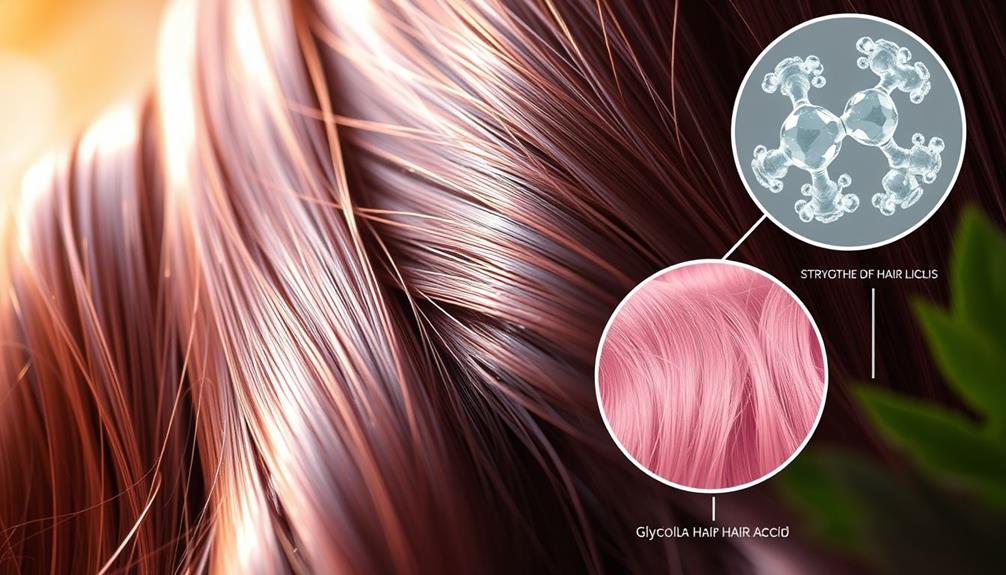
Glycolic acid works wonders for your hair by gently exfoliating your scalp, which helps promote a healthier environment for hair growth.
Its small molecular size allows it to penetrate the hair shaft effectively, enhancing moisture absorption and overall hair health.
By addressing both exfoliation and absorption, glycolic acid can greatly improve your hair's quality and manageability.
Regular scalp care is essential for maintaining healthy hair, much like how understanding a cat's body language is key to interpreting its feelings and needs cat behavior and emotional bonds.
Exfoliation and Scalp Health
Exfoliating your scalp with glycolic acid can effectively remove dead skin cells and promote healthier hair growth. This powerful acid acts as an exfoliant, enhancing cell turnover and reducing buildup on your scalp. By clearing away dead skin, you create a healthier environment for hair follicles, leading to improved scalp health and potentially increasing hair density.
Additionally, incorporating essential oils such as Tea Tree or Peppermint can complement the effects of glycolic acid by providing antimicrobial properties and promoting scalp circulation essential oils benefits.
Glycolic acid also helps balance pH levels, which is vital for maintaining a healthy scalp. Its small molecular size allows it to penetrate deeply, enhancing moisture retention and alleviating dryness and flakiness. As you incorporate glycolic acid into your hair care routine, you may notice reduced dandruff and irritation, thanks to its ability to eliminate excess sebum and debris.
The benefits of glycolic acid extend beyond just cleaning your scalp. Regular use can smooth hair cuticles, resulting in improved texture and shine.
Enhanced Hair Absorption
By enhancing scalp health through exfoliation, you set the stage for improved absorption of moisture and nutrients in your hair, allowing glycolic acid to work its magic more effectively.
This powerful hair care ingredient penetrates deeply into the hair shaft due to its small molecular size, leading to enhanced absorption compared to traditional products. Incorporating gentle yoga stretches before bedtime can also contribute to overall relaxation, which indirectly benefits hair health as stress reduction is essential for maintaining a healthy scalp yoga for back pain relief.
As it exfoliates dead skin cells from your scalp, glycolic acid creates a healthier environment that boosts the efficacy of conditioners and treatments.
In addition, the ingredient balances pH levels in hair products, which is essential for moisture retention. When your hair maintains ideal moisture levels, it stays hydrated and manageable.
Moreover, glycolic acid reduces friction and entanglement among hair strands, minimizing breakage during styling. This means you're not just improving your scalp's health; you're also promoting healthier hair overall.
Incorporating glycolic acid into your hair care routine allows you to maximize the benefits of your products. With enhanced absorption and effective moisture retention, you'll notice a significant difference in the energy and appearance of your hair.
Embrace glycolic acid for a transformative hair care experience.
Key Benefits for Hair Health
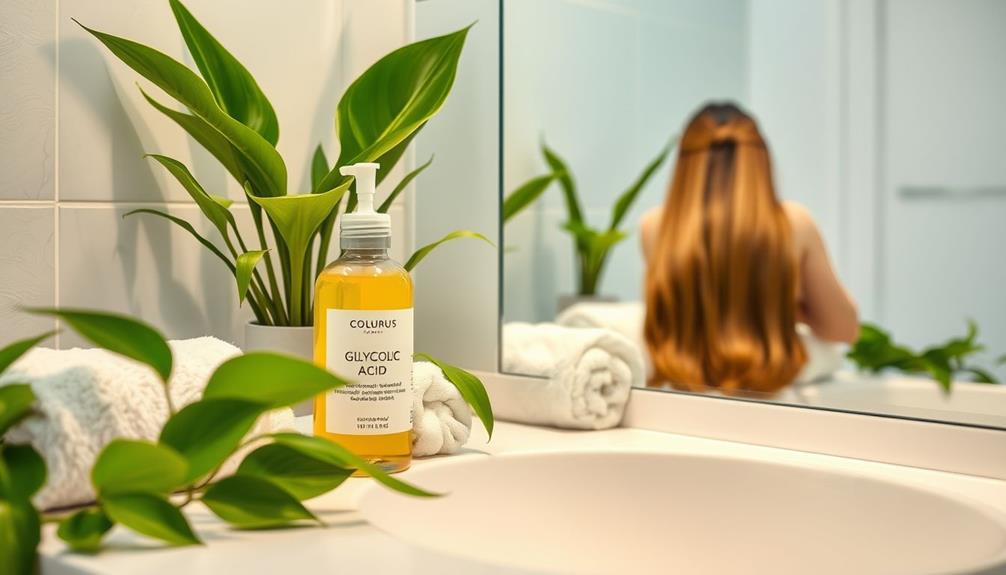
When you incorporate glycolic acid into your hair care routine, you'll notice key benefits for your hair health.
It helps exfoliate the scalp, enhancing moisture retention and leading to improved texture.
Regular use of hair treatments for damaged hair can complement the effects of glycolic acid.
With consistent use, you can enjoy a healthier scalp and more manageable hair.
Exfoliation and Scalp Health
Glycolic acid effectively exfoliates the scalp, removing dead skin cells and excess oil to create a healthier environment for hair growth. Regular use can prevent clogged hair follicles, which is crucial for maintaining peak scalp health. With a balanced pH, glycolic acid helps reduce dryness, breakage, and supports overall hair strength.
Here's a quick look at how glycolic acid benefits your scalp health:
| Benefits | Description |
|---|---|
| Exfoliation | Removes dead skin cells and excess oil |
| Clogged Hair Follicles | Prevents blockages that can lead to hair loss |
| Scalp Acne & Dandruff | Reduces bacteria, alleviating scalp issues |
| Hair Growth | Creates an ideal environment to promote healthy hair |
Incorporating glycolic acid into your hair care routine can greatly enhance your scalp health. It even tackles issues like scalp acne and dandruff, ensuring a comfortable scalp that encourages hair growth. By focusing on exfoliation, you're setting the foundation for healthier, more vibrant hair every day.
Enhanced Moisture Retention
Enhanced moisture retention is essential for maintaining healthy hair, and glycolic acid plays a key role in achieving that. This powerful ingredient penetrates the hair shaft effectively, improving hydration levels and softening the hair texture.
With its small molecular size, glycolic acid binds water molecules, greatly increasing moisture content while reducing dryness. Incorporating ingredients that support air quality, like air purifiers, can further enhance your hair care routine by creating a healthier environment free from pollutants that may impact hair health.
When you incorporate glycolic acid into your hair care routine, you'll notice enhanced moisture retention, leading to improved hair manageability and reduced breakage. By maintaining ideal hydration levels, it creates a balanced environment for your hair, making it easier to style and manage.
Additionally, glycolic acid helps balance pH levels in your scalp, preventing dryness and flakiness that can hinder moisture retention. Regular use of products containing glycolic acid can promote a healthier overall appearance for your hair.
You'll find that your strands feel softer and look shinier, reflecting the benefits of improved hydration levels.
Improved Hair Texture
Improving hair texture is another significant benefit of incorporating glycolic acid into your hair care routine, as it smooths the cuticle for shinier, more manageable locks.
When you use a glycolic acid serum, you'll harness its powerful exfoliating properties, which help remove dead skin cells and product buildup from your scalp. This creates a healthier environment for hair growth, allowing your hair to thrive.
Moreover, glycolic acid enhances moisture retention in your hair strands, making them softer and less prone to breakage. You'll notice that your hair feels less brittle and more resilient, especially if it's been chemically treated or damaged.
Regular use of glycolic acid in scalp treatments can also balance pH levels, alleviating dryness and dandruff, which further contributes to improved hair texture.
These benefits for hair translate to a noticeable difference in overall hair health. By incorporating glycolic acid into your routine, you're not just improving your hair texture; you're nurturing your hair from the roots to the tips.
Embrace the transformative effects of glycolic acid, and enjoy the journey to healthier, more beautiful hair!
Safe Application Guidelines

To guarantee safe use of glycolic acid on your scalp, stick to concentrations between 5-10% and limit applications to once a week. This approach helps minimize the risk of scalp irritation while promoting scalp health. If you have sensitive skin or existing skin conditions, patch testing is essential before fully applying glycolic acid. This simple step guarantees compatibility and prevents adverse reactions.
| Guideline | Details |
|---|---|
| Concentration | Use 5-10% for safe application |
| Frequency | Limit to once a week |
| Patch Testing | Test on a small area before full application |
Avoid applying glycolic acid on broken or compromised skin, as this can exacerbate irritation. If you're unsure about whether it's safe for your scalp type, consulting a dermatologist is a wise choice. Also, remember to apply sunscreen after using glycolic acid products, as they increase UV sensitivity and the risk of sunburn. By following these guidelines, you can enjoy the benefits of exfoliating the scalp without compromising your safety.
Risks and Precautions

While glycolic acid offers numerous benefits for your hair, it's crucial to be aware of the potential risks and precautions to guarantee safe use.
First and foremost, if you have sensitive skin or existing scalp conditions, you should avoid using glycolic acid altogether. Open sores or very dry areas can exacerbate irritation, leading to increased discomfort.
When using glycolic acid, you may experience side effects such as redness, itchiness, or overdrying, especially with higher concentrations. To minimize these risks, consider patch testing the product before full application. This can help identify any potential allergic reactions or sensitivities your skin may have.
Additionally, be cautious about UV sensitivity. Glycolic acid can heighten your skin's vulnerability to the sun, so it's best to apply products containing it in the evening and wear sunscreen during the day.
Limit your use to once a week to prevent prolonged exposure, which can lead to irritation or burning sensations. By taking these precautions, you can enjoy the benefits of glycolic acid while minimizing potential negative effects.
Alternatives to Glycolic Acid

If you're looking for alternatives to glycolic acid for hair health, there are several effective options worth considering. These alternatives can help with exfoliation, hydration, and overall scalp health without the potential irritation that glycolic acid might cause.
| Alternative | Benefits |
|---|---|
| Lactic Acid | Milder exfoliation and hydration |
| Anti-fungal Shampoos | Treats dandruff and scalp issues |
| Apple Cider Vinegar | Cleanses and maintains scalp health |
| Tea Tree Oil | Antimicrobial properties |
Minoxidil is another option commonly used for hair regrowth, while finasteride is available but not recommended for premenopausal women. If you prefer natural remedies, apple cider vinegar and tea tree oil can effectively cleanse and maintain scalp health. Additionally, anti-fungal shampoos containing ketoconazole or salicylic acid can target dandruff and other issues.
For those seeking alternative therapies, derma rolling and red light therapy can support hair growth and improve scalp conditions. These options provide a range of benefits, ensuring you have plenty of alternatives to glycolic acid for healthier hair and scalp.
Causes of Hair Loss

Hair loss can stem from various factors, including genetic conditions, autoimmune disorders, and lifestyle choices. Understanding these causes can help you take proactive steps to maintain your hair's health. Here are three common causes of hair loss:
- Androgenetic alopecia: This genetic condition affects both men and women, leading to thinning hair and baldness over time. It primarily impacts hair follicles, shrinking them and reducing hair growth.
- Traction alopecia: If you wear tight hairstyles consistently, you might experience this type of hair loss. The constant tension can damage your hair and scalp health, leading to noticeable thinning in affected areas.
- Temporary hair loss: This can occur due to stress or hormonal changes, especially during significant life events. Conditions like seborrheic dermatitis can also contribute by causing excess oil buildup on your scalp, affecting hair follicles.
Frequently Asked Questions
What Does Glycolic Acid Do to Your Hair?
Glycolic acid exfoliates your scalp, removing dead skin and buildup. It enhances moisture retention, improves hair texture, and promotes healthier growth while reducing scalp issues like acne and dandruff. You'll notice softer, shinier locks.
What Happens if You Leave Glycolic Acid in Your Hair Overnight?
Leaving glycolic acid in your hair overnight can turn your scalp into a desert! You risk irritation, dryness, and breakage. Stick to short applications, patch test first, and always follow up with a nourishing conditioner.
How Long Does It Take for Glycolic Acid to Work on Hair?
It typically takes a few weeks for glycolic acid to show noticeable effects on your hair and scalp. You might see improvements in texture and moisture retention after about four to six weeks of consistent use.
Can I Use Glycolic Acid 7% on My Hair?
Using 7% glycolic acid on your hair can feel like a magical transformation. Just apply it to your scalp, massage gently, and let it work wonders for healthier hair and a balanced scalp environment.
Conclusion
Glycolic acid might seem like a skincare staple, but its benefits for hair health are truly impressive.
By gently exfoliating and promoting scalp circulation, it can help revitalize your locks and encourage growth.
If you're worried about using acids on your hair, think of it like a revitalizing facial for your scalp—inspiring and rejuvenating.
So go ahead, give glycolic acid a try; your hair might just be the vibrant, healthy mane you've always wanted!
Glycolic Acid
Glycolic Acid Exfoliating Toner: Why It’s a Must for Clear Skin
Keen to unlock radiant skin? Discover how glycolic acid exfoliating toner can transform your complexion and why it’s essential for your skincare routine.
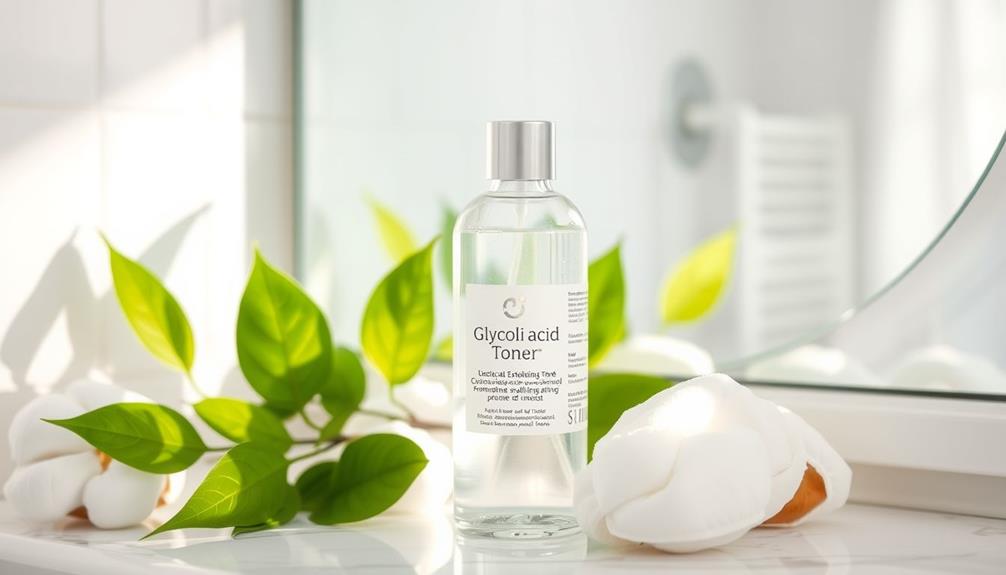
Glycolic acid exfoliating toner is essential for achieving clear, radiant skin. This powerful alpha-hydroxy acid gently dissolves bonds between dead skin cells, promoting cell turnover and revealing a brighter complexion. With regular use, it improves texture and fades fine lines by boosting collagen production. Suitable for various skin types, it helps control excess oil, making it a perfect addition to your skincare routine. Be mindful of potential sensitivity, and always follow with a hydrating serum or moisturizer and sunscreen during the day. Curious about incorporating it into your routine effectively? There's more insight ahead!
Key Takeaways
- Glycolic acid exfoliating toner promotes cell turnover, revealing smoother skin and enhancing overall complexion clarity.
- A 7% concentration effectively targets dullness, making skin appear brighter over time.
- Regular use enhances collagen production, reducing fine lines and improving skin elasticity.
- Exfoliating toners improve absorption of skincare products, maximizing their effectiveness on the skin.
Understanding Glycolic Acid

Glycolic acid, a potent alpha-hydroxy acid derived from sugar cane, penetrates your skin deeply to effectively promote exfoliation and reveal a more radiant complexion.
This powerful ingredient works by dissolving the bonds between dead skin cells, allowing for their gentle removal.
As you incorporate glycolic acid into your skincare routine, you'll likely notice significant improvement in your skin texture and tone.
Additionally, using products infused with essential oils can enhance your skincare experience, providing soothing benefits that complement glycolic acid's exfoliating effects.
Glycolic acid is suitable for various skin types, particularly normal, combination, and oily skin.
However, if you have sensitive skin, it's crucial to proceed with caution.
Start with a lower concentration, typically between 5% to 10%, to minimize irritation while still benefiting from its exfoliating properties.
Regular use can enhance collagen production, which improves skin elasticity and reduces the appearance of fine lines and wrinkles.
Benefits of Exfoliating Toner
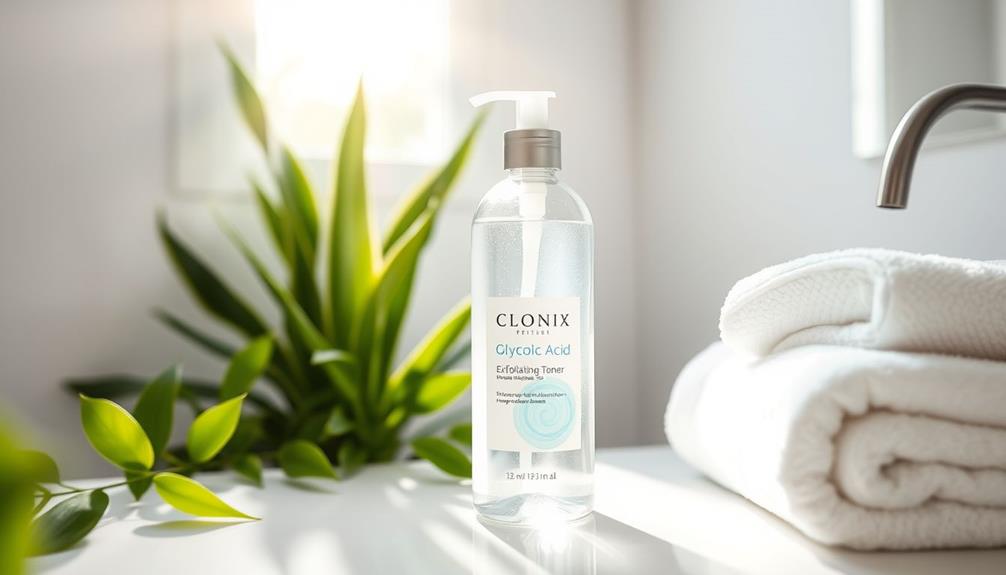
Exfoliating toners offer a range of benefits that enhance your skincare routine, from improving texture to boosting radiance.
A glycolic acid exfoliating toner effectively promotes cell turnover, helping to reveal smoother skin by dissolving the bonds between dead skin cells. With a concentration of 7%, it targets dullness and improves the appearance of your skin over time, leading to a brighter, more even complexion.
Additionally, incorporating essential oils into your regimen, such as essential oils for skin health, can further enhance your skin's liveliness and overall well-being.
Regular use of this toner can also minimize the appearance of fine lines and wrinkles, enhancing skin firmness and elasticity by stimulating collagen production.
If you have oily skin, you'll find that glycolic acid toners can help reduce blemishes and prevent breakouts, making them an essential part of your skin care regimen.
Furthermore, these toners enhance the absorption of subsequent skincare products, ensuring that serums and moisturizers deliver their benefits more effectively.
Incorporating an exfoliating toner into your routine not only improves your skin texture but also greatly boosts your overall skin radiance.
The consistent use of a glycolic acid exfoliating toner can transform your complexion, making it look vibrant and healthy.
How to Use Glycolic Acid

To get the most out of glycolic acid, start with a toner that has around 7% concentration for gentle exfoliation. This lower concentration helps improve skin texture without overwhelming sensitive skin.
Incorporating a calming routine, similar to how gentle yoga stretches can ease tension before bedtime, can enhance your overall skincare experience.
Apply the product once daily in the evening using a cotton pad on clean, dry skin, carefully avoiding your eye area and any broken or peeling skin.
After applying the toner, follow up with a hydrating serum or moisturizer to replenish moisture, as glycolic acid can cause dryness. It's important to maintain your skin's hydration, especially after exfoliating.
Initially, use the toner twice a week, gradually increasing to three times a week as your skin builds tolerance. Monitor for any signs of irritation during this process.
Remember that glycolic acid increases your skin's sensitivity to sun exposure. Always apply sunscreen with a broad-spectrum SPF of at least 30 during the day to protect your newly exfoliated skin.
With consistent use and proper protection, you'll notice a significant improvement in your skin texture and clarity.
Skin Types and Suitability

Understanding your skin type is key to determining if glycolic acid is the right choice for your skincare routine. Glycolic acid products work wonders for normal, combination, and oily skin, addressing issues like dullness and uneven texture. However, if you have dry skin, you should proceed with caution, as it may cause irritation. Starting with lower concentrations is advisable.
Here's a quick guide to help you assess your skin type and how glycolic acid can fit in:
| Skin Type | Suitability | Notes |
|---|---|---|
| Normal Skin | Excellent for exfoliation and glow | Keeps skin fresh and vibrant |
| Combination Skin | Great for balancing oily and dry areas | Targets specific zones effectively |
| Oily Skin | Ideal for controlling excess oil | Reduces blemishes and improves texture |
| Dry Skin | Use with caution | Start with lower concentrations |
| Sensitive Skin | Consult a dermatologist | Avoid potential irritation |
| Mature Skin | Beneficial for elasticity and fine lines | Leverages collagen-stimulating properties |
Potential Side Effects and Precautions

Using glycolic acid can sometimes lead to mild redness or irritation, especially for those new to it or with sensitive skin. You might notice peeling or dryness, so it's vital to moisturize adequately to maintain your skin's hydration.
Incorporating a calming bedtime routine can help reduce stress and improve skin health, as stress can exacerbate skin sensitivities. Additionally, consider adding gentle yoga stretches to your daily routine, as they may promote relaxation and enhance overall well-being.
If you're introducing glycolic acid into your routine, consider patch testing first to identify any allergic reactions before applying it to your entire face.
Additionally, be aware that glycolic acid can make your skin more sensitive to sunlight. It's important to use sunscreen with at least SPF 30 daily to protect your skin from UV damage. This precaution helps prevent any adverse reactions and maintains the appearance of skin texture, especially as you target signs of skin aging.
When using glycolic acid products, avoid the eye contour area, as this skin is particularly delicate. If you experience severe irritation or signs of an allergic reaction, discontinue use immediately and consult a physician.
Frequently Asked Questions
Does Glycolic Acid Make Your Skin Clear?
Yes, glycolic acid can help make your skin clear. It exfoliates, removes dead skin cells, and encourages cell turnover, which reduces blemishes and improves texture, promoting a brighter, more even complexion over time.
Why Is Glycolic Acid Toner Good for Skin?
Think of glycolic acid toner as your skin's spring cleaning. It gently sweeps away dead cells, revealing brighter skin beneath. You'll notice improved texture, reduced fine lines, and enhanced absorption of your favorite products.
What Happens if You Use Glycolic Acid Toner Everyday?
If you use glycolic acid toner every day, you might experience irritation, redness, or peeling. Start with 2-3 times a week, then gradually increase use while monitoring your skin's response for any adverse effects.
What Does Glycolic Exfoliating Toner Do?
Imagine peeling an orange; glycolic exfoliating toner does the same for your skin, removing dead cells and revealing a fresh layer. It smooths texture, reduces dark spots, and enhances your skin's ability to absorb other products effectively.
Conclusion
Just like a gardener prunes a tree to encourage new growth, using a glycolic acid exfoliating toner helps your skin shed its old, dull layers, revealing a fresher, more vibrant complexion underneath.
It's your skin's secret weapon against blemishes and uneven texture.
As you nurture your garden, remember to listen to your skin's needs; with care and consistency, you'll cultivate the clear, radiant glow you've always desired.
Embrace the journey to beautiful skin—it's worth every drop!
Glycolic Acid
Glycolic Acid: How It Can Transform Your Skin’s Appearance
Transform your skin with glycolic acid and uncover the secrets to a smoother, more radiant complexion that will leave you wanting to learn more.

Glycolic acid, derived from sugar cane, can transform your skin's appearance by enhancing exfoliation and boosting collagen production. When you incorporate it into your routine, you'll notice smoother texture and a more radiant glow. It accelerates cell turnover, helping fade dark spots and improve uneven skin tone. Plus, it can keep your pores clear, reducing acne breakouts. Start with a low concentration and gradually increase usage for the best results. Don't forget sunscreen, as glycolic acid can heighten sensitivity to the sun. There's plenty more to discover about how this powerhouse ingredient can benefit your skin.
Key Takeaways
- Glycolic acid exfoliates the skin, enhancing texture and promoting a radiant complexion by accelerating cell turnover.
- It reduces hyperpigmentation and dark spots, leading to a more even skin tone with consistent use.
- Glycolic acid helps control acne by keeping pores clear and reducing the occurrence of breakouts.
- Incorporating glycolic acid into your routine can stimulate collagen production, improving skin firmness and reducing fine lines.
What Is Glycolic Acid?
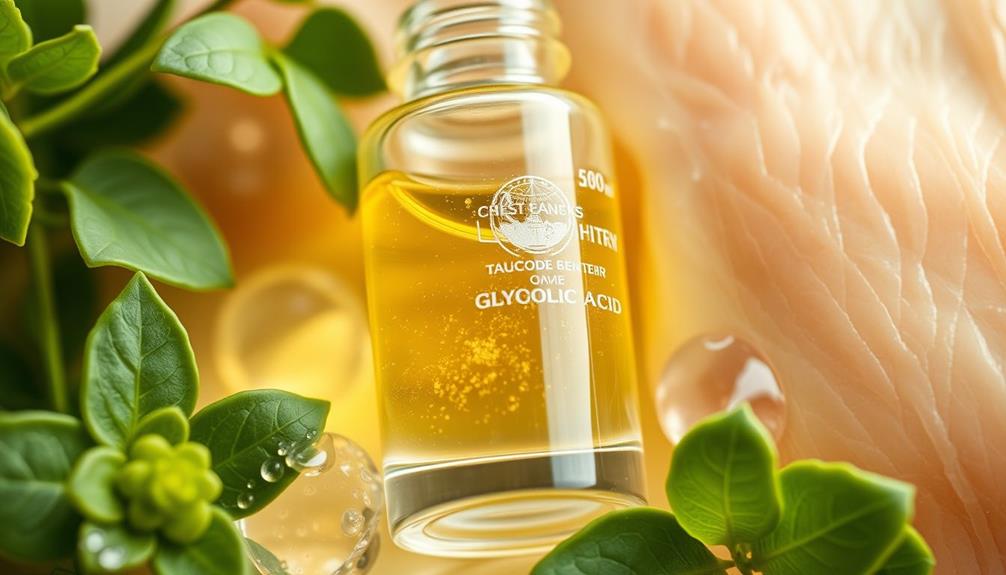
Glycolic acid, a powerful exfoliant derived from sugar cane, penetrates deeply into your skin to reveal a smoother, more radiant complexion. As one of the most popular alpha hydroxy acids (AHAs), it's celebrated for its remarkable exfoliating properties.
By effectively removing dead skin cells, glycolic acid helps improve skin texture, allowing fresh skin to surface and enhancing your overall appearance. Additionally, incorporating essential oils into your routine can complement glycolic acid's effects, promoting better skin health and overall well-being.
Incorporating glycolic acid into your skincare routine can address various skin concerns, including uneven skin tone, roughness, and signs of aging. This potent ingredient not only exfoliates but also stimulates collagen production, which is vital for maintaining skin firmness and reducing the appearance of fine lines and wrinkles.
You'll find glycolic acid in a variety of skincare products, such as cleansers, toners, serums, and peels, making it versatile for different skin types.
Whether you're looking to brighten your complexion or tackle specific skin issues, glycolic acid is an effective choice. By choosing the right formulations, you can harness its transformative benefits and enjoy a healthier, more vibrant skin texture.
Benefits for Skin Health

Glycolic acid offers a range of benefits that can greatly enhance your skin health.
It not only exfoliates and improves texture, but it also helps reduce hyperpigmentation and controls acne breakouts.
Additionally, incorporating essential oils into your skincare routine can provide natural alternatives to chemical products that further support skin health.
Exfoliation and Texture Improvement
Regularly using glycolic acid can transform your skin by effectively exfoliating dead cells and improving texture for a smoother, more radiant appearance.
As the smallest alpha hydroxy acid (AHA), glycolic acid penetrates deeply, accelerating exfoliation and promoting cell turnover. This process removes dead skin cells, revealing fresh, new skin underneath. Incorporating gentle techniques, such as yoga stretches, can complement your skincare routine by enhancing circulation and promoting relaxation.
With consistent use, you'll notice a significant reduction in roughness and uneven skin tone. Glycolic acid works by breaking down the bonds between dead skin cells, resulting in a refined surface that feels softer and looks more vibrant.
Not only does it enhance your skin texture, but it also stimulates collagen production, which is essential for maintaining firmness and a youthful glow.
Moreover, glycolic acid can help fade dark spots, contributing to an overall more even complexion. By incorporating this powerful ingredient into your skincare routine, you're not just addressing superficial surface concerns but also promoting long-term skin health.
Hyperpigmentation Reduction
One of the key benefits of incorporating glycolic acid into your skincare routine is its ability to effectively reduce hyperpigmentation and promote a more even skin tone.
Glycolic acid accelerates cell turnover, helping to fade dark spots and pigmented skin cells. Additionally, utilizing skincare patches can enhance the absorption of glycolic acid, allowing for targeted treatment of areas with hyperpigmentation.
By regularly using this powerful ingredient, you can inhibit melanin production, which reduces the formation of new pigmented areas.
Clinical studies have shown that consistent application of glycolic acid greatly improves skin texture and helps diminish sunspots and post-inflammatory hyperpigmentation.
Its small molecular size allows it to penetrate deeply, enhancing its effectiveness in targeting pigmentation issues more than larger molecules found in other AHAs.
As you incorporate glycolic acid into your regimen, you'll likely notice visible improvements in skin clarity and brightness.
This brightening effect not only addresses hyperpigmentation concerns but also contributes to an overall healthier appearance.
With regular use, you'll be on your way to achieving a smoother, more even skin tone that radiates confidence.
Embrace glycolic acid as a transformative addition to your skincare routine, and watch your skin thrive.
Acne and Breakout Control
In addition to improving hyperpigmentation, glycolic acid plays a significant role in acne and breakout control by gently exfoliating the skin and keeping pores clear. If you have acne-prone skin, incorporating glycolic acid into your routine can help reduce the appearance of active lesions and prevent future breakouts. By accelerating cell turnover, glycolic acid dissolves the bonds between dead skin cells, preventing the formation of comedones, which are a primary cause of acne.
| Benefit | Description |
|---|---|
| Exfoliating Action | Removes dead skin cells, revealing healthier skin. |
| Smoother Skin | Regular use leads to a softer, more even texture. |
| Antibacterial Properties | Helps inhibit bacterial growth for fewer breakouts. |
| Improved Complexion | Promotes a clearer, more vibrant appearance. |
With its powerful antibacterial properties, glycolic acid contributes to a healthier complexion, making it a game-changer for anyone struggling with acne. Make it a staple in your skincare routine, and you'll likely notice a significant improvement in your skin's overall health and appearance.
How Glycolic Acid Works

Glycolic acid's exfoliation mechanism is key to its effectiveness, as it breaks down the bonds holding dead skin cells together.
Its small molecular size allows it to penetrate deeply, enhancing cell turnover and addressing hyperpigmentation issues.
Incorporating mindful eating and regular exercise can also support overall skin health, as stress management techniques improve overall well-being.
Exfoliation Mechanism Explained
By loosening the bonds that cling dead skin cells to your complexion, glycolic acid paves the way for smoother, healthier skin beneath. As the smallest molecule in the alpha hydroxy acids (AHAs) family, its effective exfoliation process allows for deeper penetration, enhancing cell turnover. This means you experience a more radiant complexion as new skin cells regenerate and replace the old ones.
Here's a quick overview of how glycolic acid impacts your skin:
| Function | Benefit |
|---|---|
| Exfoliation | Removes dead skin cells |
| Cell Turnover | Promotes regeneration of new cells |
| Smooth Texture | Enhances skin's overall feel |
| Targets Skin Concerns | Addresses issues like acne and hyperpigmentation |
| pH Adjuster | guarantees mildness in formulations |
Skin Penetration Depth
As the smallest AHA, glycolic acid penetrates your skin more deeply and effectively than larger molecules, allowing for profound rejuvenation. This deep skin penetration enhances its exfoliating action, which is vital for revealing a fresh, vibrant layer of skin beneath.
Additionally, incorporating antioxidant-rich ingredients like rooibos tea can further enhance your skincare routine, promoting overall skin health due to its rich in antioxidants.
Here's how glycolic acid transforms your skincare routine:
- Dead Skin Cell Removal: Glycolic acid loosens the bonds between dead skin cells, facilitating their removal and improving your skin's texture.
- Stimulates Collagen Production: By reaching the deeper layers of the epidermis, it promotes collagen production, resulting in firmer, more youthful skin over time.
- Increased Sensitivity to UV Rays: This potent acid can make your skin more sensitive to UV rays, so it's essential to incorporate a broad-spectrum sunscreen into your daily routine.
Effects on Hyperpigmentation
Effective in combating hyperpigmentation, glycolic acid accelerates cell turnover to lift and disperse excess melanin from your skin's surface.
By using glycolic acid as an exfoliant, you can effectively slough off dead skin cells, revealing a brighter complexion beneath.
Its small molecular size allows it to penetrate deeply, targeting melanocytes to inhibit melanin production directly, which helps lighten dark spots over time.
Clinical studies show that regular use of glycolic acid can considerably diminish sunspots and post-inflammatory hyperpigmentation.
As you incorporate this powerful ingredient into your routine, you'll not only notice improvements in skin tone but also enhanced skin texture.
Glycolic acid promotes collagen production, leading to improved elasticity and a more youthful appearance.
With consistent application, you can achieve a more even-toned complexion and a radiant glow.
Remember to start slowly to allow your skin to adjust, and always follow up with sunscreen during the day, as glycolic acid can increase your skin's sensitivity to the sun.
Embrace glycolic acid, and watch your skin transform, tackling hyperpigmentation like never before.
Risks and Precautions

Using glycolic acid can lead to increased skin sensitivity, making it essential to take precautions to avoid irritation and damage. To guarantee a safe and effective experience, consider these important tips:
- Start with low concentrations: Begin with a product containing 5-10% glycolic acid. This allows your skin to gradually build tolerance and minimize potential side effects like redness, burning, or peeling.
- Monitor your skin's response: Pay close attention to how your skin reacts. If you experience severe irritation, discontinue use immediately and apply soothing products to help restore your skin barrier.
- Always wear sunscreen daily: Glycolic acid can heighten your skin's sensitivity to UV radiation. To prevent sunburn and further skin damage, make sure to apply a broad-spectrum sunscreen with SPF 30 or higher every day.
Choosing the Right Product

Finding the right glycolic acid product for your skin can greatly enhance your skincare routine and boost your results.
Start by considering your skin type; oily skin often benefits from toners, while dry or mature skin may prefer creams. When you choose a glycolic acid product, aim for a low concentration of 5-10% to gauge your skin's tolerance. This allows you to gradually increase the strength, potentially up to 20%, as your skin adjusts.
Look for products containing a pH around 4, which complements your skin's natural acidity and maximizes the effectiveness of glycolic acid use. Additionally, check for beneficial ingredients like hyaluronic acid or niacinamide, which can help hydrate your skin and minimize irritation.
It's essential to avoid using glycolic acid alongside other potent chemical exfoliants like retinoids or salicylic acid to reduce the risk of skin irritation.
Application Tips and Techniques
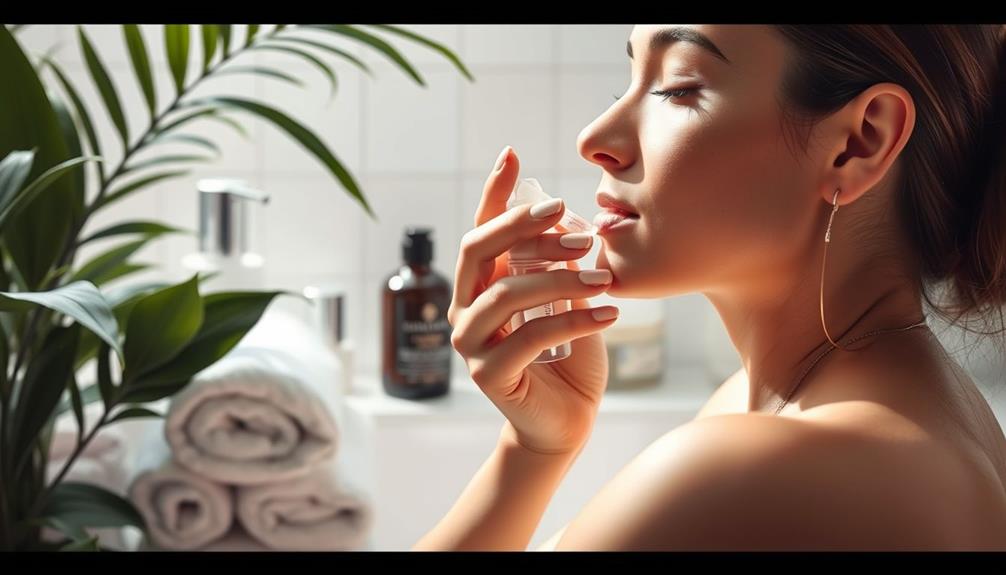
To get the most out of glycolic acid, start with a low concentration and gradually increase frequency as your skin adjusts. This way, you'll minimize irritation and help maintain skin elasticity.
Here are some essential application tips:
- Perform a patch test: Before applying glycolic acid all over your face, test it on a small area of your skin. This step is crucial, especially if you have sensitive skin, to guarantee you won't have an adverse reaction.
- Apply at night: Use glycolic acid products on clean, dry skin in the evening. This timing helps reduce sun sensitivity and allows the product to absorb better.
- Follow up with moisturizer and sunscreen: After applying glycolic acid, use a hydrating moisturizer to combat any dryness. The next morning, don't forget to apply a broad-spectrum sunscreen (SPF 30+) to protect your skin from UV exposure, as glycolic acid can make your skin more sensitive to the sun.
Expected Results Over Time
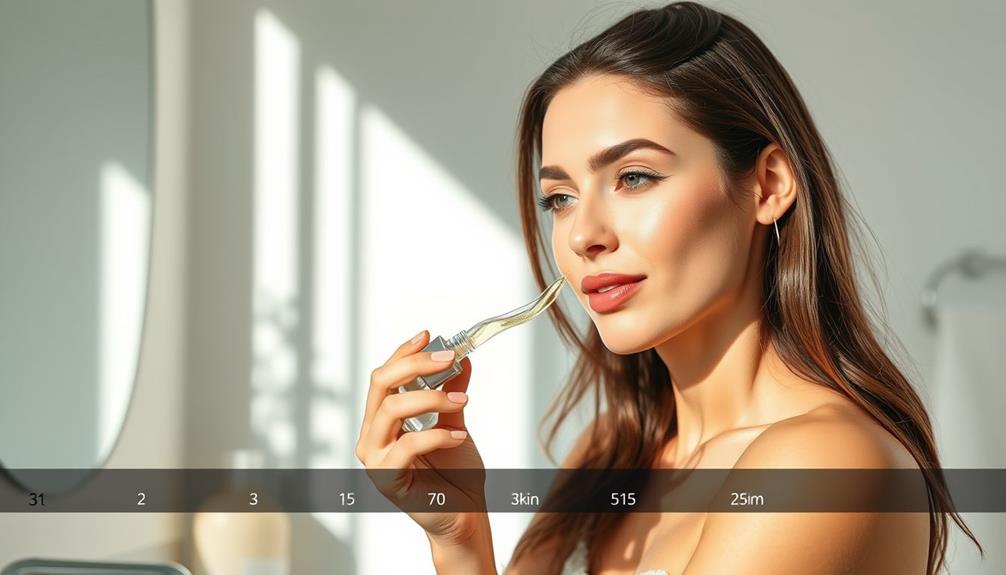
Regularly incorporating glycolic acid into your skincare routine can lead to noticeable improvements in your skin's texture and overall appearance over time.
Within just 2 weeks, you might experience enhanced hydration as glycolic acid acts as a humectant, attracting moisture to your skin.
In about 4-6 weeks, many users notice visibly smoother skin, thanks to the exfoliation of dead skin cells and increased cell turnover.
If you're struggling with acne, you could see a significant reduction in breakouts around this same timeframe, as glycolic acid helps clear pores and minimize the formation of comedones.
After about 6-8 weeks, you may also notice dark spots and hyperpigmentation starting to fade, leading to a more even skin tone and increased radiance.
With consistent use over 8-12 weeks, you might see a reduction in fine lines and wrinkles as glycolic acid stimulates collagen production.
Glycolic Acid Vs. Other Acids
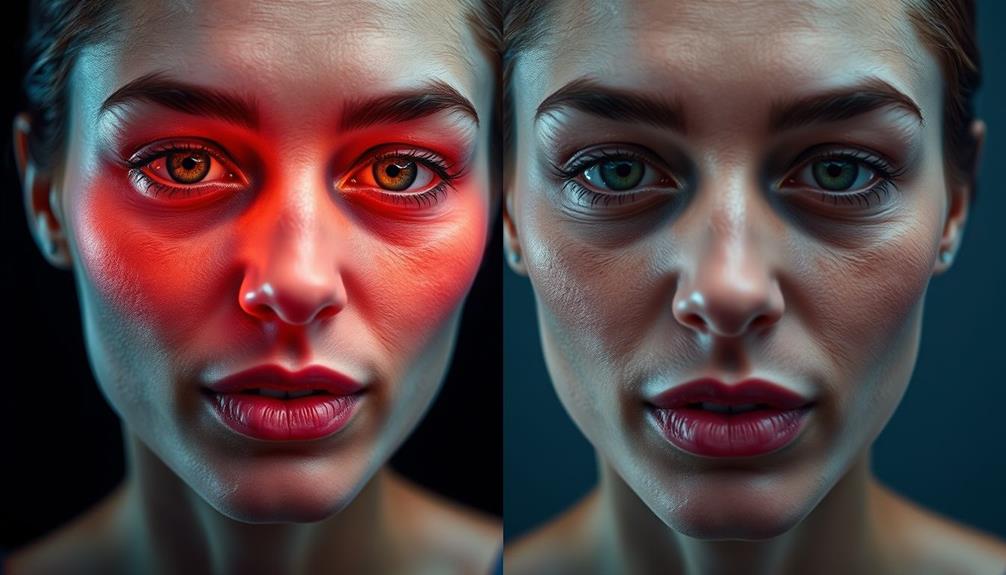
When comparing glycolic acid to other acids like mandelic and kojic, you'll notice distinct differences in their effects and applications.
Glycolic acid is a powerhouse for exfoliation,
while mandelic acid is gentler on sensitive skin,
and kojic acid shines as a brightening agent.
Understanding these differences helps you choose the right acid for your skincare needs.
Glycolic Vs. Mandelic Acid
Glycolic and mandelic acids each offer unique benefits for your skin, making it essential to understand their differences for ideal results. Both belong to the alpha hydroxy acids (AHAs) family, but they cater to different needs. Here's a breakdown of their key differences:
- Exfoliation Method: Glycolic acid, with its small molecular structure, penetrates the skin quickly, providing rapid exfoliation and promoting cell turnover. In contrast, mandelic acid's larger size results in gentler exfoliation, making it more suitable for sensitive skin.
- Skin Texture Improvement: If you're targeting acne and want to enhance skin texture, glycolic acid is your go-to. However, if you have darker skin tones, mandelic acid can be less aggressive, reducing irritation and the risk of hyperpigmentation.
- Anti-Aging Effects: For visible anti-aging effects, glycolic acid shines, offering deeper pore cleansing. Meanwhile, mandelic acid provides additional antibacterial and anti-inflammatory benefits, making it a milder choice with minimal irritation.
Choosing between glycolic and mandelic acid depends on your skin type and specific concerns.
Glycolic Vs. Kojic Acid
The debate between glycolic and kojic acid highlights their distinct roles in skincare, with glycolic excelling in exfoliation and texture improvement, while kojic focuses on brightening and pigmentation reduction.
Glycolic acid, an alpha hydroxy acid (AHA), penetrates deeply to dissolve dead skin cells, making it ideal for tackling skin concerns like uneven texture and signs of aging.
On the other hand, kojic acid inhibits tyrosinase to reduce melanin production, effectively targeting dark spots and hyperpigmentation.
You'll find that glycolic acid is more suited for oily and acne-prone skin due to its powerful exfoliating properties. However, it can increase sensitivity to the sun and may cause irritation, especially in higher concentrations.
Conversely, kojic acid is gentler and often recommended for sensitive skin types, though it can still cause allergic reactions in some individuals.
Combining these two acids in your skincare routine can enhance overall effectiveness, as glycolic acid promotes cell turnover, while kojic acid brightens the complexion.
Just remember to use caution to avoid irritation from over-exfoliation.
Common Misconceptions
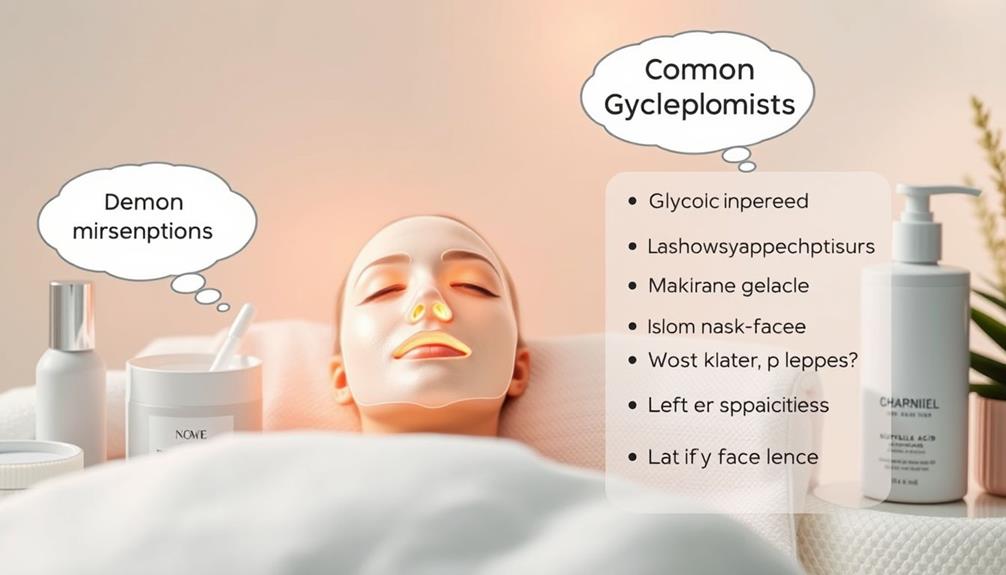
Many people mistakenly believe that glycolic acid is only for oily skin, but it can actually benefit all skin types, including dry and sensitive skin, when used properly. Here are some common misconceptions you should be aware of:
- Immediate Results: Many think glycolic acid delivers instant results, but you'll typically need consistent use over several weeks to notice significant improvements in your skin's texture and tone.
- Higher Concentrations Are Better: Some assume that stronger is always better. In reality, starting with lower concentrations (5-10%) is advisable. This approach helps you build tolerance and minimizes the risk of skin sensitivity.
- No Need for Sun Protection: It's a common myth that glycolic acid can be used without sun protection. In fact, it increases your skin's sensitivity to UV rays, making daily sunscreen application essential.
Incorporating Into Your Routine

Incorporating glycolic acid into your skincare routine can transform your complexion when done thoughtfully and gradually.
Start with a low concentration of glycolic acid (5-10%) and use it just once or twice a week. This allows you to monitor your skin's response and assess any sensitivity.
Always apply glycolic acid products in the evening after cleansing. This timing maximizes effectiveness while minimizing the risk of sun sensitivity, as glycolic acid can increase your skin's vulnerability to UV rays.
Before applying it to your face, perform a patch test on a small area to check for any adverse reactions, especially if you have sensitive skin.
After applying glycolic acid, follow up with a hydrating moisturizer to combat potential dryness and support your skin barrier.
Remember, consistency is key. You'll also need to apply sunscreen daily, ideally a broad-spectrum SPF 30 or higher, to protect your skin from increased sensitivity and prevent pigmentation issues.
Frequently Asked Questions
What Does Glycolic Acid Do to Your Skin?
Glycolic acid exfoliates your skin, boosts cell turnover, and fades dark spots. It stimulates collagen production, improving firmness and elasticity, while also attracting moisture for hydration, resulting in a clearer, more youthful complexion.
Does Glycolic Acid Change Skin Tone?
Yes, glycolic acid can change your skin tone. It exfoliates dead skin cells, promotes cell turnover, and fades dark spots, leading to a brighter, more even complexion over time. Regular use enhances your skin's overall clarity.
What Is the Result of Glycolic Acid on Face?
When you use glycolic acid on your face, you'll notice smoother skin, reduced fine lines, and improved texture. It helps brighten your complexion, diminishes dark spots, and hydrates, giving you a more youthful appearance.
How Long Does It Take to See Changes With Glycolic Acid?
You'll feel like you've revealed a secret to radiant skin! Typically, you'll notice changes in 4 to 6 weeks, with even more stunning results surfacing around 8 to 12 weeks with consistent use.
Conclusion
Incorporating glycolic acid into your skincare routine can truly revolutionize your complexion, almost like discovering the fountain of youth!
With consistent use, you'll notice smoother, brighter skin and a reduction in fine lines.
Just remember to start slow and listen to your skin's needs.
Whether you're battling acne or simply looking to enhance your glow, glycolic acid is a game-changer.
So, get ready to reveal a more radiant you—your skin's future is looking bright!
Glycolic Acid
Can Glycolic Acid Shrink Pores? What the Experts Say
Learn how glycolic acid can transform your skin and minimize pores, but what do the experts really say about its effectiveness?

Yes, glycolic acid can shrink the appearance of your pores. This powerful exfoliant removes dead skin cells, helping to unclog pores and prevent oil buildup. Experts agree that regular use boosts collagen production, which firms your skin and makes pores less noticeable. Clinical studies show that consistent glycolic acid application can lead to visible improvements in just four weeks. Dermatologists recommend incorporating glycolic acid into your skincare routine for its proven benefits in enhancing texture and minimizing pores. There's a lot more to discover about how to optimize its effects for your skin.
Key Takeaways
- Glycolic acid is an effective exfoliant that removes dead skin cells, unclogging pores and minimizing their appearance.
- Regular use of glycolic acid stimulates collagen production, which firms skin and reduces visibility of enlarged pores.
- Clinical studies show noticeable improvements in pore size and skin texture within four weeks of consistent glycolic acid application.
- Dermatologists recommend incorporating glycolic acid into skincare routines for enhanced skin health and reduced pore size.
Glycolic Acid Explained

Glycolic acid is a powerful exfoliant that helps your skin shed dead cells, making it smoother and reducing the appearance of pores. As an alpha-hydroxy acid (AHA), it effectively exfoliates the skin by breaking down the bonds between dead skin cells. This guarantees easier removal and promotes a clearer complexion.
By regularly incorporating glycolic acid into your skincare routine, you can greatly reduce pore size and improve your skin's overall texture. Additionally, using natural products such as essential oils for skin care can complement the effects of glycolic acid by providing nourishment and promoting overall skin health.
Not only does glycolic acid exfoliate the skin, but it also stimulates collagen production. This is vital for firming the skin and preventing pores from stretching, which contributes to the appearance of enlarged pores. If you're concerned about clogged pores, glycolic acid can help cleanse them by removing trapped dead skin cells, oil, and dirt buildup.
One of the best features of glycolic acid is its suitability for various skin types, including sensitive skin. It's often found in combination products aimed at acne-prone individuals, making it a versatile choice for anyone looking to enhance their skincare regimen.
With consistent use, you'll likely notice a notable improvement in your skin's clarity and firmness.
Scientific Evidence on Pore Size

Research has consistently shown that regular use of glycolic acid can effectively shrink the appearance of pores, enhancing your skin's overall texture. By incorporating glycolic acid into your skincare routine, you can take advantage of its powerful exfoliating properties, which help to unclog pores and reduce pore size over time.
Here's a quick overview of how glycolic acid works:
| Effect | Mechanism | Result |
|---|---|---|
| Exfoliation | Removes dead skin cells | Unclogs pores |
| Collagen Production | Stimulates collagen synthesis | Firms skin, minimizes size of enlarged pores |
| Acne Control | Combines with salicylic acid | Addresses acne and pore size issues |
Clinical studies support these claims, with one showing a 10% glycolic acid formulation can lead to visible results within four weeks. Additionally, research indicates that 71% of women aged 20-35 feel more confident with less noticeable pores, underscoring the psychological benefits of effective treatments like glycolic acid. Embracing glycolic acid in your routine could be the key to achieving smoother, clearer skin.
Expert Opinions on Efficacy

When it comes to the effectiveness of glycolic acid, expert opinions back its use for reducing pore size.
Dermatologists highlight its ability to gently exfoliate and improve skin texture, making it a go-to recommendation.
Incorporating regular skincare routines that include mindful eating and hydration can further enhance skin health.
You'll find that clinical studies consistently support these claims, showcasing significant benefits for your skin.
Clinical Study Findings
Numerous clinical studies have shown that glycolic acid effectively reduces the appearance of enlarged pores and improves skin texture over time.
For instance, a study published in the Journal of Cosmetic Dermatology revealed that a 10% glycolic acid treatment led to a noticeable reduction in pore size within just four weeks of consistent use.
Additionally, research in the Journal of the American Academy of Dermatology highlighted the effectiveness of combining glycolic acid with salicylic acid, especially for those with acne-prone skin, addressing both pore size and acne simultaneously.
Incorporating regular exfoliation into your skincare routine is essential, as it mirrors the importance of regular vet check-ups for monitoring a cat's health.
Dermatologists consistently endorse glycolic acid for its ability to enhance skin texture while minimizing the appearance of enlarged pores.
Dr. Ava Shamban emphasizes the importance of exfoliation, which glycolic acid facilitates by removing dead skin cells that often clog pores and contribute to their enlargement.
Regular use of glycolic acid-based products can lead to significant long-term improvements in pore appearance and overall skin health.
Dermatologist Recommendations
Many dermatologists recommend glycolic acid for its proven efficacy in reducing the appearance of enlarged pores and enhancing overall skin texture.
This powerful exfoliant works by dissolving dead skin cells, which helps prevent clogged pores. Additionally, incorporating gentle yoga stretches into your routine can promote relaxation, further benefiting skin health by reducing stress-related skin issues.
Dr. Ava Shamban emphasizes that by keeping your skin clear of buildup, glycolic acid not only improves the look of your pores but also promotes healthier skin overall.
Clinical studies support these claims, showing that consistent use of a 10% glycolic acid formulation can reduce pore size in as little as four weeks.
Experts like Dr. Rachel Nazarian highlight glycolic acid's gentle nature, making it suitable for various skin types without causing irritation. Regular use can boost collagen production, further improving skin elasticity and texture.
To achieve the best results, dermatologists recommend incorporating glycolic acid into your skincare routine gradually. Start with a lower concentration and increase as your skin adjusts.
By following these dermatologist recommendations, you can effectively tackle enlarged pores while reaping the benefits of smoother, clearer skin.
Embrace glycolic acid as a key component in your journey to enhanced skin health and appearance.
Recommended Glycolic Acid Products

Here are some key benefits of using glycolic acid products:
- Exfoliating properties: They gently remove dead skin cells, promoting cell turnover for a fresh complexion. Understanding the importance of <a target="_blank" href="https://howlingwolfherbs.com">sustainable harvesting methods</a> can enhance your approach to skincare ingredients.
- Minimize their appearance: Regular use can considerably reduce pore size, making them less noticeable.
- Enhanced skin texture: You'll likely notice a smoother, more even skin surface over time.
Importance of Pore Refinement

Pore refinement plays a significant role in boosting your confidence and enhancing your overall appearance.
Smaller pores often give off a more youthful vibe, making you feel better about how you look.
Additionally, practices like self-exploration through body awareness can contribute to a more positive self-image.
Plus, the psychological impact of having smoother skin can elevate your mood and self-esteem.
Confidence With Smaller Pores
Feeling more confident often comes from having smoother skin with less noticeable pores, a desire echoed by many in today's beauty standards. When you achieve smaller pores, it can greatly boost your self-esteem and change how you perceive yourself.
Here's how pore refinement can impact your confidence:
- You might notice a smoother skin texture, making makeup application easier and more flawless.
- Smaller pores can enhance your overall appearance, giving you a fresh, polished look.
- The psychological impact of reduced visibility of enlarged pores can lead to greater self-assurance in social situations.
Clinical evidence shows that products containing glycolic acid effectively refine pores, making them less noticeable. As dermatologists endorse this treatment, you're not just improving your skin's appearance—you're actively working on boosting your confidence.
With each use, you're on your way to achieving that smoother, clearer complexion. Embrace the process and enjoy the benefits of feeling more confident in your skin!
Youthful Appearance Benefits
Achieving smaller pores not only boosts your confidence but also plays a key role in enhancing your youthful appearance. Many women believe that reducing pore size contributes considerably to looking younger, and studies show they're right.
Consistent use of glycolic acid can visibly improve skin texture while minimizing the appearance of pores. This powerful ingredient works by exfoliating dead skin cells, allowing fresh skin to emerge, which ultimately leads to enhanced pore refinement.
Moreover, glycolic acid stimulates collagen production, helping to firm your skin and further reduce the visibility of enlarged pores. As you use glycolic acid, you'll notice a smoother skin texture that reinforces the perception of youthfulness.
Dermatologists have found that minimizing the appearance of pores is a major concern for many, especially women aged 20-35. By incorporating glycolic acid into your skincare routine, you can achieve not just a beautiful complexion but a more youthful look overall.
Psychological Impact of Pores
The appearance of enlarged pores can greatly impact your self-esteem, making pore refinement an essential aspect of many people's skincare journeys.
A study by SK-II revealed that a significant number of American women feel more confident with less noticeable pores. The psychological impact of pore visibility can often lead to feelings of inadequacy, pushing individuals to seek effective skincare solutions.
Consider the benefits of achieving smaller pores:
- Enhanced self-esteem as you embrace your natural beauty
- A more youthful appearance that reflects energy and health
- Increased confidence in social situations, allowing you to shine
With 74% of participants believing that smaller pores contribute to beauty, it's clear that pore refinement is more than just a cosmetic choice.
It's about feeling good in your skin and improving your mental well-being. The obsession with pore size, sometimes termed "porexia," underscores the need for effective skincare solutions like glycolic acid.
Understanding Pore Structure
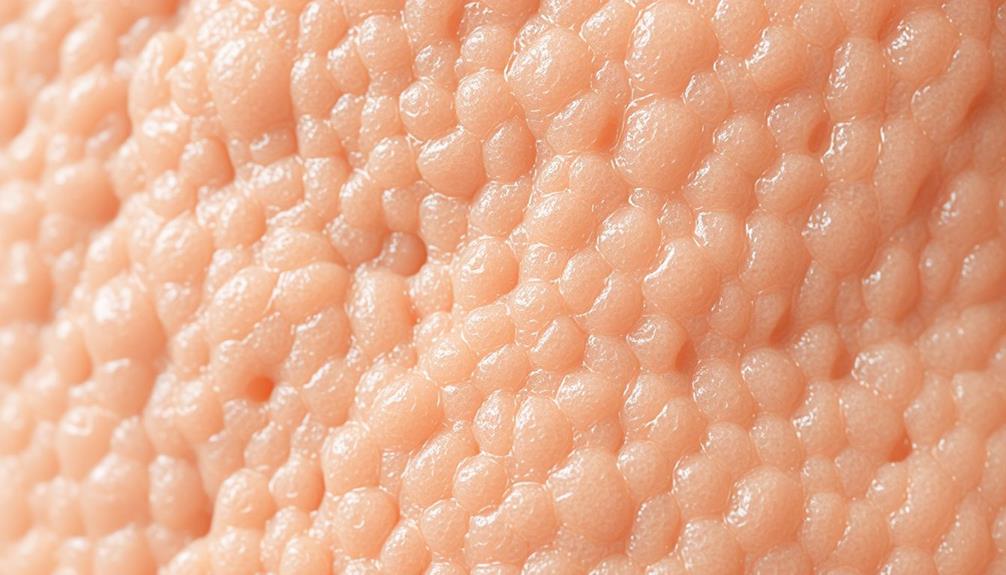
Understanding the structure of pores reveals how they function as vital pathways for sweat and oil, important for maintaining healthy skin.
Pores are tiny openings in your skin, averaging around 20,000 on your face alone. They're especially concentrated on areas like your nose and forehead, where sebaceous glands produce oil. The size of your pores is largely influenced by genetics, with oily skin types typically having larger pores due to excess sebum production.
As you age, your skin experiences a loss of collagen and elastin, which can cause your pores to appear larger. This is why maintaining skin health is significant—not just for appearance but for function.
While you can't change the permanent nature of pores, you can work to reduce their appearance through informed skincare choices.
Glycolic acid is one ingredient that can help in this regard. By promoting skin cell turnover and improving overall texture, it may enhance the appearance of your pores.
However, understanding pore structure is the first step in addressing any concerns. With the right approach, you can help your skin look its best while ensuring that your pores continue to function effectively.
Benefits of Glycolic Acid

Glycolic acid offers impressive benefits for your skin, primarily through its exfoliating properties that promote skin renewal.
By breaking down dead skin cells, it not only smooths your skin texture but also enhances collagen production, helping to keep your pores looking tight.
Incorporating glycolic acid into your routine can lead to a healthier, more radiant complexion.
Exfoliation and Skin Renewal
Exfoliating with glycolic acid effectively removes dead skin cells, paving the way for smoother, more radiant skin. By breaking down the bonds between those dead cells, glycolic acid enhances skin renewal and improves overall skin texture. You'll notice significant benefits, especially if you have acne-prone skin or enlarged pores.
Here's what you can expect from regular glycolic acid use:
- Reduced pore size: Consistent exfoliation helps minimize the appearance of pores.
- Smoother skin texture: Say goodbye to rough patches and hello to a refined complexion.
- Fewer breakouts: By unclogging pores and removing oil and dirt, glycolic acid helps prevent blemishes.
Dermatologists recommend incorporating glycolic acid into your skincare routine for its gentle yet powerful effects. As it promotes exfoliation and skin renewal, you'll enjoy a clearer complexion and a boost in confidence.
Whether you're dealing with enlarged pores or uneven skin, glycolic acid is a fantastic solution that can help you achieve the skin you've always wanted.
Collagen Production Enhancement
By boosting collagen production, glycolic acid not only enhances skin elasticity and firmness but also helps reduce the appearance of enlarged pores.
When you incorporate glycolic acid into your skincare routine, you're actively stimulating collagen synthesis, which is essential for maintaining a smooth and youthful skin texture.
Dermatologists often recommend glycolic acid because it's shown to be more effective in enhancing collagen levels compared to other acids.
This increase in collagen helps prevent pores from stretching, ultimately reducing the size of large pores over time.
As you regularly use glycolic acid-based products, you can expect visible improvements in both your skin texture and the overall appearance of your pores within just a few weeks.
Managing Enlarged Pores

Managing enlarged pores effectively involves incorporating glycolic acid into your skincare routine, as it helps to unclog pores and promote cell turnover. By using glycolic acid regularly, you can reduce the appearance of enlarged pores and enjoy clearer skin. Here's how it works:
- Exfoliation: Glycolic acid promotes regular exfoliation, removing dead skin cells that contribute to pore size.
- Collagen Production: It stimulates collagen production, improving skin texture over time.
- Oil Control: Regular use prevents the buildup of oil and dirt in pores, minimizing their visibility.
As you integrate glycolic acid into your skincare routine, you'll notice a smoother complexion and reduced pore size. Dermatologists recommend it as a safe and effective option for all skin types.
Skincare Routine Tips

To achieve the best results in reducing the appearance of enlarged pores, it's important to establish a consistent skincare routine tailored to your skin's needs.
Start by using a gentle cleanser twice daily to remove excess oil and dirt, which can help minimize pores.
Regularly exfoliate 2-3 times a week with products containing glycolic acid or other AHAs; this promotes skin cell turnover and prevents clogged pores.
Incorporate a lightweight, non-comedogenic moisturizer to keep your skin hydrated without blocking pores.
After cleansing, using toners with astringent properties can help balance your skin's pH and tighten pores, enhancing the overall appearance.
Make sure to apply a broad-spectrum sunscreen every day to protect collagen and elastin, which are essential for maintaining skin structure and preventing pore enlargement over time.
Treatments for Pore Minimization

Exploring glycolic acid treatments can greatly enhance your efforts in minimizing the appearance of enlarged pores. These treatments work by exfoliating the skin and stimulating collagen production, which helps reduce pore size and improve your overall skin texture.
Here are some effective options to evaluate:
- Over-the-Counter Glycolic Acid Products: Look for lotions and gels that you can use daily.
- Professional Chemical Peels: These treatments, performed by dermatologists, can provide more dramatic results.
- Combining Ingredients: Pair glycolic acid with salicylic acid for enhanced effects, especially if you have acne-prone skin.
Regular use of these treatments can lead to visible improvements in just a few weeks. By incorporating glycolic acid into your skincare routine, you'll not only tackle enlarged pores but also promote firmer, smoother skin.
Whether you're opting for at-home solutions or professional help, the journey to refined pores starts with the right glycolic acid treatment.
Frequently Asked Questions
Does Glycolic Acid Reduce Pore Size?
Yes, glycolic acid reduces pore size by exfoliating dead skin cells and promoting collagen production. With regular use, you'll notice unclogged pores and improved skin texture, making it an effective addition to your skincare routine.
Do Dermatologists Recommend Glycolic Acid?
Yes, dermatologists often recommend glycolic acid for its effectiveness in improving skin texture and reducing the appearance of pores. Its gentle exfoliation helps prevent clogged pores, making it a suitable choice for various skin types.
Which Acid Is Best for Shrinking Pores?
When it comes to shrinking pores, glycolic acid is often your best bet due to its exfoliating properties. Salicylic acid can also help, especially for oily skin. Consider trying both for ideal results.
What Is the Most Effective Pore Minimizer?
To effectively minimize pores, you should consider ingredients like glycolic acid, salicylic acid, or retinoids. These help exfoliate, unclog, and tighten your skin, giving you a smoother, more refined complexion over time.
Conclusion
So, can glycolic acid really shrink pores?
While it may not literally reduce their size, it can help improve skin texture and clarity, making pores appear less noticeable.
Think of it as a gentle exfoliation that keeps your skin smooth and radiant.
Combine it with a solid skincare routine and you'll likely see a difference over time.
Embrace the journey to healthier skin—your pores just might thank you for it!
-

 Vetted4 months ago
Vetted4 months ago15 Best Sports Recovery Tools to Enhance Your Performance and Speed Up Healing
-

 Nutrition1 day ago
Nutrition1 day agoJoin the Low Carb Craze and Lose Weight Fast!
-

 Nutrition1 day ago
Nutrition1 day agoEat Healthy With This Atkins Carbohydrate Counter!
-

 Lifestyle4 months ago
Lifestyle4 months agoHealthy Lifestyle Blogs – Follow for Inspiration and Tips!
-

 Nutrition1 day ago
Nutrition1 day agoGet the Keto Ratio Right for Maximum Results!
-

 Nutrition1 day ago
Nutrition1 day agoGuide : How To Count Calories
-

 Lifestyle4 months ago
Lifestyle4 months agoHealthy Lifestyle Podcast – Tune In for Wellness Tips!
-

 Vetted4 months ago
Vetted4 months ago7 Best Books on Ayurvedic Lifestyle for a Healthier You



















